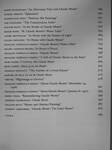1.034.830
kiadvánnyal nyújtjuk Magyarország legnagyobb antikvár könyv-kínálatát

VISSZA
A TETEJÉRE
JAVASLATOKÉszre-
vételek
Claude Monet
1840-1926
| Kiadó: | Könemann Verlagsgesellschaft mbH |
|---|---|
| Kiadás helye: | Köln |
| Kiadás éve: | |
| Kötés típusa: | Fűzött keménykötés |
| Oldalszám: | 387 oldal |
| Sorozatcím: | |
| Kötetszám: | |
| Nyelv: | Angol |
| Méret: | 34 cm x 25 cm |
| ISBN: | 3-89508-049-7 |
| Megjegyzés: | Színes reprodukciókkal. További kapcsolódó személyek a műben. |
naponta értesítjük a beérkező friss
kiadványokról
naponta értesítjük a beérkező friss
kiadványokról
Fülszöveg
As one of the outstanding representatives of Impressionism, Claude Monet (1840-1926) ranks amongst the great artistic innovators of the 19th century. What was new and - in terms of its effect upon painting - revolutionary about the approach adopted by Monet and some of his contemporaries was the fact that they painted their pictures in the open air. Rather than restricting themselves to simply sketching from nature, they actually completed the large part of their canvases on site. Monet was one of the first to relocate his studio outdoors in this manner. He was thereby concerned not with objects as such, but with their appearance at a certain moment - at a certain time of day, under certain weather conditions, or in a certain light. Thus he became the painter of sunlit landscapes, stormy seas, and the exuberance of vegetal colour in his garden. Above all, he became the painter of light.
For a long time, Monet's break with the academic conventions of his day earned him only... Tovább
Fülszöveg
As one of the outstanding representatives of Impressionism, Claude Monet (1840-1926) ranks amongst the great artistic innovators of the 19th century. What was new and - in terms of its effect upon painting - revolutionary about the approach adopted by Monet and some of his contemporaries was the fact that they painted their pictures in the open air. Rather than restricting themselves to simply sketching from nature, they actually completed the large part of their canvases on site. Monet was one of the first to relocate his studio outdoors in this manner. He was thereby concerned not with objects as such, but with their appearance at a certain moment - at a certain time of day, under certain weather conditions, or in a certain light. Thus he became the painter of sunlit landscapes, stormy seas, and the exuberance of vegetal colour in his garden. Above all, he became the painter of light.
For a long time, Monet's break with the academic conventions of his day earned him only ridicule and rejection. The first decades of his career were dogged by constant financial worries. His art was appreciated in those early years by just a small number of colleagues and critics. It was only later, once Impressionism had finally established itself, that Monet came to be generally admired and indeed revered.
The present book traces the development of attitudes towards Monet's art, drawing upon contemporary reviews and commentaries and incorporating the opinions of such famous writers as Proust, Zola, Maupassant, Mallarmé, and Clemenceau, the French statesman and Monet's long-standing friend. Monet himself, in interviews, offers his personal thoughts on his ouvre, on the beginnings of the Impressionist movement, and on his collectors and patrons. In addition, first-hand recollections of the artist by visitors to Giverny, the country home in which Monet spent the second half of his life, combine to create a multi-faceted picture of his person: a remarkable man who commanded profound respect.
The text is lavishly complemented with 122 colour illustrations, including 8 large fold-out plates, and 119 black-and-white illustrations. Vissza
Témakörök
- Életrajz > Művészet > Festészet, szobrászat
- Idegennyelv > Idegennyelvű könyvek > Angol > Művészetek > Festészet
- Idegennyelv > Idegennyelvű könyvek > Angol > Művészetek > Művészettörténet, általános
- Idegennyelv > Idegennyelvű könyvek > Angol > Életrajz > Művészet > Festészet, szobrászat
- Művészetek > Művészettörténet általános > Idegen nyelv > Angol
- Művészetek > Művészettörténet általános > Életrajzok > Festők
- Művészetek > Festészet > Korszakok, stílusok > XIX. század > Impresszionizmus
- Művészetek > Festészet > Életrajzok > Külföldi
- Művészetek > Festészet > Idegen nyelv > Angol
- Művészetek > Festészet > Tanulmányok, összefoglalók > Külföldi
- Művészetek > Festészet > Albumok > Külföldi festők
- Művészetek > Festészet > Általános festészet > Története
Megvásárolható példányok
Nincs megvásárolható példány
A könyv összes megrendelhető példánya elfogyott. Ha kívánja, előjegyezheti a könyvet, és amint a könyv egy újabb példánya elérhető lesz, értesítjük.











